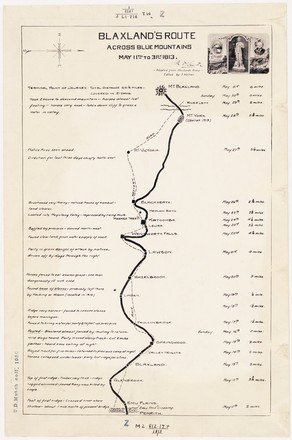Blaxland's route across Blue Mountains, May 11th to 31st 1813
1937
M2 812.17p/1937/1
Map
By 1813 Gregory Blaxland had already made two previous expeditions into the foothills of mountains to explore the territory. Based on his knowledge of the terrain, he concluded that it might be possible to cross the Mountains following a ridge running between the Warragamba and Grose Rivers. Blaxland, Wentworth and Lawson were successful in their crossing because they followed the ridge lines across the mountains, avoiding the most of the steep, disorientating valleys.
This map was produced in around 1937. It is based on a map in a 1913 edition of Blaxland’s journal edited by Frank Walker, and shows the route taken by Blaxland, Wentworth and Lawson across the Blue Mountains in 1813. It also includes notes on the journey, and distances travelled each day, alongside what became the Main Western Road which is now the Great Western Highway.
More land for cattle
Soon after he arrived in Sydney in 1806, Gregory Blaxland acquired over 4000 acres of land in various parts of the colony which he developed into large pastoral estates and stockyards. His herds quickly outgrew his holdings and despite requests for more coastal land grants, Blaxland realised that the only way to increase the amount of land available for grazing was to conquer the Blue Mountains and develop the land on the other side. He had already investigated the areas along the Nepean River, and he asked Governor Macquarie to support an expedition across the Mountains.
In 1813, he set out with William Charles Wentworth and William Lawson from his property in South Creek (near present day Kemps Creek). The men’s success lay in the fact that they chose to climb the mountains via the ridges, rather than finding a path through the valleys.
The explorers were each rewarded with 1000 acres of land in the newly discovered country, but curiously, only William Lawson took it up. Blaxland later asked Governor Macquarie for additional grazing land in the interior, which Macquarie refused, forcing him to sell off much of his livestock. Their relationship was already strained, as Macquarie expected Blaxland, as a large landholder, to contribute to the grain store of the Colony, but since his interests were in stock, he had failed to do this. Miffed, Blaxland became a vocal critic of Macquarie’s administration and devoted himself to experimenting with agricultural crops at his Brush Farm estate.



 Back to list
Back to list